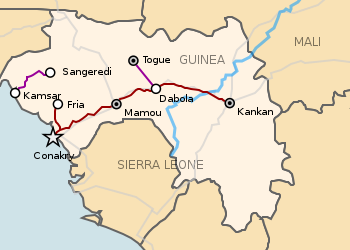Guinea has 1,086 km of railways. This includes 279 km at 1,435 mm (4 ft 8+1⁄2 in) gauge and 807 km at 1,000 mm (3 ft 3+3⁄8 in) gauge. The latter includes 662 km in common carrier service from Kankan to Conakry.[citation needed]

Currently operating in Guinea three different railway companies:
- Chemin de Fer de Guinée (ONCFG),
- Chemins de Fer de la Compagnie des Bauxites de Guinée - Chemin de Fer de Conakry (CBG) and
- Chemin de Fer Boké.
The current status
editThe state owned railway line from Conakry to Kankan
editIn June 1959, the state-owned railway company ONCFG (Office National des Chemins de Fer de Guinée) was founded. The property of the former French colonial Conakry-Niger rail authority has been transferred to it.
Into the following years all the rolling stock weren't maintained. Since 1993 with exception of fuel shipments to Mamou the rail traffic is suspended.
In 2008, the government of Guinea was in talks with Rio Tinto and BHP Billiton about renovation of the Conakry-Kankan line.[1][2]
In 2010 the Brazilian company Vale began work on rebuilding the Conakry to Kankan railroad. As part of an agreement with the government of Guinea, Vale is investing to refurbish the railroad, which will transport passengers and general freight between capital city Conakry and Kankan in the east of the country. By rebuilding the railroad, Vale is contributing to the social and economic development of the African country, potentially creating thousands of jobs.
A major public transport development milestone was achieved in Guinea during June 2010 with the start of the Conakry Express. The Chinese International Funding (CIF) funded initiative has delivered a passenger rail transport system, The Conakry Express will hugely improve the movement of people through the 30 km (19 mi) long route.[3]
Mining companies railway links
editThree railway lines are used to transport bauxite to the coast:
- In the 1970s opened a 136 km (85 mi) long standard gauge railway link from Kamsar to Boké and Sangarédi. The route is operated by the CBG mining company. CBG transports 12,000,000 t (11,800,000 long tons; 13,200,000 short tons) of bauxite and minerals annually.
- The narrow gauge railway line Conakry - Fria (called CFCF = Chemin de fer Conakry – Fria) have a length of 143 km (89 mi) and is operated by the Russian aluminum giant RusAl (in 2006 acquired from Friguia SA). The route was built in the 1960s and are in good condition. Between Fria and Conakry transported more than 900,000 t (886,000 long tons; 992,000 short tons) of goods (600,000 t or 591,000 long tons or 661,000 short tons aluminate, 200,000 t or 197,000 long tons or 220,000 short tons petroleum products and 100,000 t or 98,400 long tons or 110,000 short tons caustic soda).
- The standard gauge railway line Conakry - Kindia have length of 105 km (65 mi) and was built with help from USSR. The route is operated by the state owned mining company Societé des Bauxites de Kindia (SBK). The transport included the delivery of bauxite (annually 1,200,000 t or 1,180,000 long tons or 1,320,000 short tons) from Kindia to Conakry harbour.
- Rio Tinto Limited planned to build a 650 km (400 mi) railway to transport iron ore from the Simandou mine to the coast, near Matakong, for export. This line has since been taken over by a Singapore led consortium.[4]
- Santou-Dapilon standard gauge railway [5] opened in 2021.
Rail links with other countries
edit- There are at present no railway connections between Guinea and its neighbouring countries.
See also
editReferences
edit- ^ "Conakry-Kankan Rail to be Renovated" Africa Mining Intelligence No. 174 27 February 2008
- ^ "Never Was Heard A Discouraging Word" The Cortellazzi Consortium (blog) March 30, 2008
- ^ "Guinea". Archived from the original on 2010-05-31. Retrieved 2010-10-03.
- ^ "GUINEA: SIMANDOU PROJECT GAINS MOMENTUM". Railways Africa. Retrieved 2010-11-09.
- ^ Mining Railway